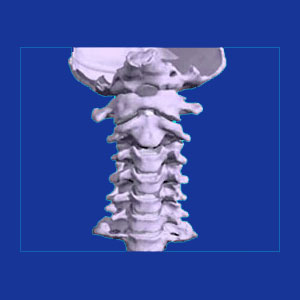
Studying the neck anatomy will sometimes provide real clues as to the true nature of chronic neck pain, so it is always advised for any neck ache sufferer to fully comprehend their diagnostic conclusion, including the affected anatomical structures in their cervical spine. The neck features a complex anatomy, with the frontal region being filled with vital structures, such as the esophagus and various glands, the sides holding some of the most important nerves and arteries in the body and the rear consisting of the all-important cervical spinal anatomy.
The scope of this anatomical article focuses on the cervical spine, since this is the area affected by most neck pain conditions.
Soft Tissues of the Neck Anatomy
There are many different types of soft tissues in the sides and rear of the neck:
The neck muscles are very important to physical functionality, since they hold the skull erect and facilitate a huge and diverse range of motion for the head. The musculature of the neck works in close partnership with the upper back muscles, the shoulder muscles and the chest muscles, and is multilayered in its design. Besides muscles, there are ligaments and tendons here as well, which serve vital functions.
The brachial plexus is a concentrated nerve center in the lower neck and upper back which is often implicated in pain syndromes.
Soft tissue injury is certainly a possible source of acute neck pain, but is rarely the underlying reason to support a chronic neck pain concern. Occasionally, injury or degeneration can create an unstable cervical spine that might require drastic medical care.
Speaking of degeneration, is cervical spine degeneration really responsible for neck pain in most patients?
Skeletal Components of the Neck Anatomy
There are 7 cervical vertebrae and 6 cervical intervertebral discs, starting with the Atlas at C1 and ending in the cervicothoracic juncture between C7 and T1. There is no disc spacer between the Atlas (C1) and the Axis (C2).
Within the vertebral foramen of the spinal column resides the spinal cord and the spinal nerve roots, as well as ligaments and other tissues.
The bones of the cervical spine are lighter and smaller than in the other spinal regions, but must be very strong to handle the tremendous stress placed on the area by the weight of the head.
Anatomy of the Neck Synopsis
The anatomy of the neck truly packs a vast diversity of tissues and functionality into a small and tight space. Chronic neck pain does not necessarily come from anatomical issues, but it is always a good idea to understand the anatomy of the neck, just in case.
Many patients find abnormalities in their neck and wonder if these concerns might be causative for cervical spine disorders or chronic pain. In some cases, the answer may be yes, while in others, there is little, if any connection. The best way to diagnose any potentially serious health issue in the cervical region, such as neck pain or a lump in the neck, is by using MRI technology, although x-rays or ultrasound may also be useful in limited circumstances.
Read more about the complexities of the cervical spine anatomy.





